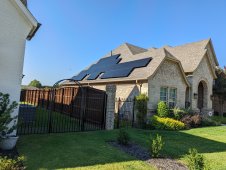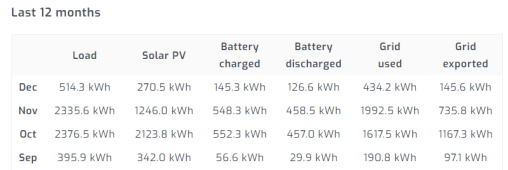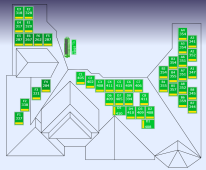My install is finally complete. This is a grid-tie system in DFW, Texas within the Oncor delivery area with no net metering available with a possible self consumption rate of 94% and estimated annual production of 24,000 kWh.
The full setup includes:
-Sol-Ark 15K
-44x440W Aptos 144 DNA panels
-Tigo 44xTS4-O optimizers and 3xTAP and CCA for panel level monitoring and rapid shutdown
-Homegrid Stack'd 38.4kWh battery
-2x Easy Start units for the A/C units
Total Cost:
- $2.55/W for PV
- $575/kWh of storage
- Total cost $71,500 before tax rebate, $50,050 after tax incentive.
This was an extremely competitive price, other quotes I have received were $3.30-$3.40/W for PV and $700-$800/kWh for storage.
Timeline:
- Started getting quotes mid-June, picked installer by end of June
- Paid 50% deposit mid-July
- Plans were ordered 7/21
- Tigo Optimizers were added to the quote on 7/29
- Got first draft of plans 8/3
- Final plans accepted 8/22
- Got city permit on 9/8
- Panels and inverter were installed 9/13-15
- Battery was installed 9/28 and I also got PTO the same day for export
- Tigo Optimizers were turned on 11/24 as I had to wait for the CCA that was backordered
Issues so far:
- One Tigo Optimizer was faulty and shut down the panel for overvoltage as soon as it was producing over 150W or so. The optimizer was replaced and the new one is working fine
- Originally my setup only had two TAP installed which caused flakiness with the communication on the east side panels. A third TAP was installed on December 8th and everything is happy now.
- The Sol-Ark 15K needed a new main board module, the one I had was not working properly with the rapid shutdown, ie. it did not shut down the system when the button was pushed. Sol-Ark sent a replacement board and I swapped it out and sent the faulty one back.
Peak generation was on 10/1 with 89 kWh. Lowest generation day was 2.7 kWh on 11/24.
Tigo is providing about 6% improvement which is well worth the 1.5% I paid for them.
I'm on a free nights plan where I pay nothing between 9PM and 7AM. I also get $0.03/kWh for solar export. So far for the last two months I had negative bills with this setup and I'm using electric heating at night to save money on natural gas even. I'm locked in for 2 years on this utility plan, if I can extend it my ROI will be 7.5 years for the entire system.
The full setup includes:
-Sol-Ark 15K
-44x440W Aptos 144 DNA panels
-Tigo 44xTS4-O optimizers and 3xTAP and CCA for panel level monitoring and rapid shutdown
-Homegrid Stack'd 38.4kWh battery
-2x Easy Start units for the A/C units
Total Cost:
- $2.55/W for PV
- $575/kWh of storage
- Total cost $71,500 before tax rebate, $50,050 after tax incentive.
This was an extremely competitive price, other quotes I have received were $3.30-$3.40/W for PV and $700-$800/kWh for storage.
Timeline:
- Started getting quotes mid-June, picked installer by end of June
- Paid 50% deposit mid-July
- Plans were ordered 7/21
- Tigo Optimizers were added to the quote on 7/29
- Got first draft of plans 8/3
- Final plans accepted 8/22
- Got city permit on 9/8
- Panels and inverter were installed 9/13-15
- Battery was installed 9/28 and I also got PTO the same day for export
- Tigo Optimizers were turned on 11/24 as I had to wait for the CCA that was backordered
Issues so far:
- One Tigo Optimizer was faulty and shut down the panel for overvoltage as soon as it was producing over 150W or so. The optimizer was replaced and the new one is working fine
- Originally my setup only had two TAP installed which caused flakiness with the communication on the east side panels. A third TAP was installed on December 8th and everything is happy now.
- The Sol-Ark 15K needed a new main board module, the one I had was not working properly with the rapid shutdown, ie. it did not shut down the system when the button was pushed. Sol-Ark sent a replacement board and I swapped it out and sent the faulty one back.
Peak generation was on 10/1 with 89 kWh. Lowest generation day was 2.7 kWh on 11/24.
Tigo is providing about 6% improvement which is well worth the 1.5% I paid for them.
I'm on a free nights plan where I pay nothing between 9PM and 7AM. I also get $0.03/kWh for solar export. So far for the last two months I had negative bills with this setup and I'm using electric heating at night to save money on natural gas even. I'm locked in for 2 years on this utility plan, if I can extend it my ROI will be 7.5 years for the entire system.
Attachments
-
 electric_bill.png97.1 KB · Views: 199
electric_bill.png97.1 KB · Views: 199 -
 PXL_20220914_145048617.jpg376.8 KB · Views: 213
PXL_20220914_145048617.jpg376.8 KB · Views: 213 -
 PXL_20220929_013833702.jpg109.2 KB · Views: 206
PXL_20220929_013833702.jpg109.2 KB · Views: 206 -
 Solar_Production.png156.1 KB · Views: 196
Solar_Production.png156.1 KB · Views: 196 -
 solar_stats.png36.5 KB · Views: 205
solar_stats.png36.5 KB · Views: 205 -
 tigo_optimizers.png84.5 KB · Views: 201
tigo_optimizers.png84.5 KB · Views: 201 -
 worst_day_production.png213.8 KB · Views: 200
worst_day_production.png213.8 KB · Views: 200
Last edited:



